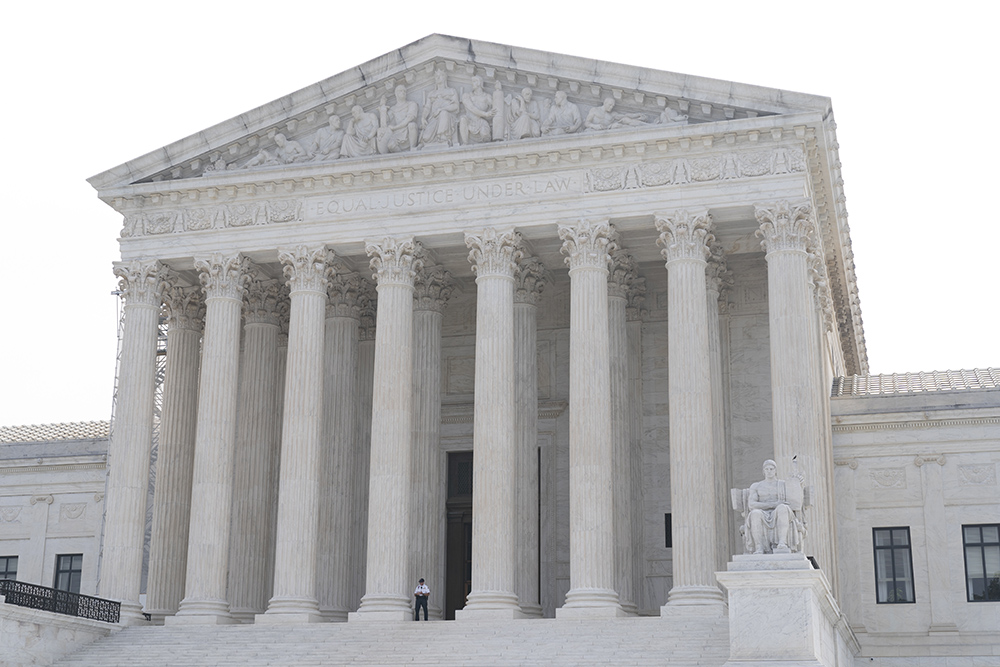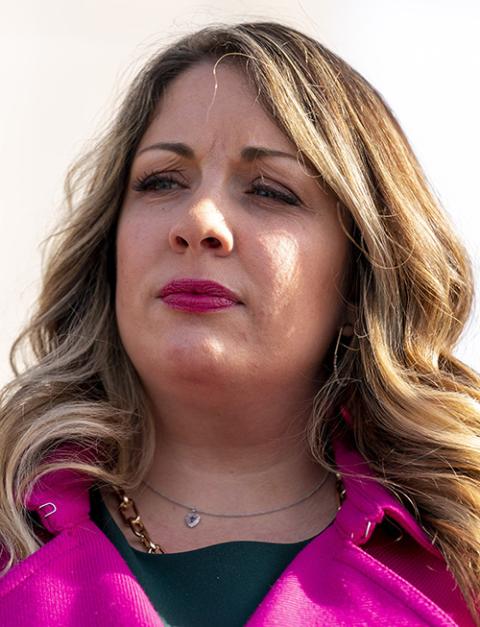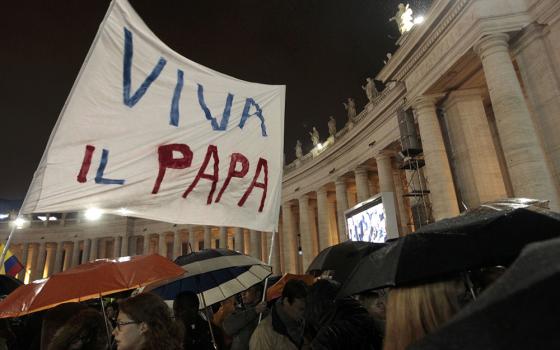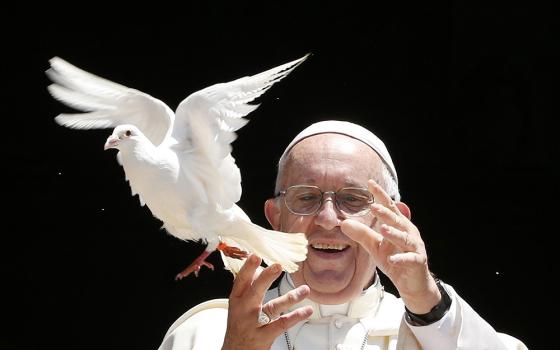
The Supreme Court is seen Friday, June 30, in Washington, D.C., as decisions were expected. (AP/Jacquelyn Martin)
Today, June 30, the Supreme Court issued its decision on 303 Creative LLC v. Elenis, a case that involves the clash between LGBTQ rights and freedom of speech. Lorie Smith, a Christian wedding website designer, challenged a Colorado law that prohibits discrimination against LGBTQ customers. She sought an exemption from nondiscrimination laws, arguing that her business involves speech. This case addresses whether she should be granted a freedom of speech exemption rather than a religious freedom exemption.
It is the latest case in a series of cases aimed at addressing the intersection of anti-discrimination laws, free exercise of religion and freedom of speech.
There were three potential outcomes in this case. Firstly, the court could have ruled that businesses open to the public must comply with nondiscrimination laws and that the freedom of speech in one's private life differs from the right to discriminate as a business. Secondly, the court could have determined that no actual harm has occurred since the business owner is not yet offering her services, deeming the case as brought too soon. Lastly, the court could have concluded that certain businesses, particularly those offering creative services categorized as speech, can discriminate in really limited circumstances. The court chose the last option.
When analyzing Supreme Court decisions, Catholics should engage in two forms of analysis: the legal analysis and a vulnerability analysis.
The legal analysis includes an analysis of current jurisprudence, legal arguments and the power dynamics at play. Past cases like Plessy v. Ferguson — which ruled that racial segregation laws did not violate the U.S. Constitution— highlight the Supreme Court's history of sometimes being on the wrong side of justice. While a Supreme Court ruling might seem legally sound, it doesn't always promote the common good or protect the vulnerable.
The vulnerability analysis focuses on the impact on the common good, with emphasis on the preferential option for the poor and vulnerable. Vulnerability is not determined by simply being a "minority" but by belonging to minoritized communities — communities that face marginalization and persecution due to systemic oppression.
While a Supreme Court ruling might seem legally sound, it doesn't always promote the common good or protect the vulnerable.
Minority is usually defined as "the smaller number of the whole." One could say that the top 1% richest people in the world are a minority but does that mean they are the most vulnerable? Clearly not.
Minoritized communities, on the other hand, are defined as "groups that are marginalized or persecuted because of systemic oppression" — systemic mistreatment of people that is historically supported and enforced by society and its institutions, solely based on a person's membership in a social group.
When assessing vulnerability in a lawsuit, it is crucial to analyze the parties involved and the purported vulnerable groups. In cases where there is a clash between two purportedly vulnerable groups, a case-by-case evaluation is needed to determine which group is more vulnerable and/or more adversely affected by the outcome.
The jurisprudential analysis
Several amicus briefs — briefs filed by nonparties intending to influence the court's decision — were filed for this case. The brief of those potentially affected by a decision should always take priority and are mentioned here.
First, in the brief submitted by "website and graphic designers in support of neither party," the amici asked the court to affirm that, "regardless of which party prevails, designers of custom websites and graphics are engaged in an expressive art and are entitled to the same protections under the First Amendment as artists using any other medium."
Another notable brief is the one submitted by Christian powerhouses, including the U.S. Conference of Catholic Bishops, the Billy Graham Evangelistic Association, the General Council of the Assemblies of God, and others.

Lorie Smith, a Christian graphic artist and website designer in Colorado, appears outside the Supreme Court in Washington, Monday, Dec. 5, 2022, after her case was heard by the court. (AP/Andrew Harnik, File)
In this brief, the amici urged the court to grant a free speech exemption "to protect individuals from compelled speech and to provide space in the public square for minority voices." By "minority voices" they specifically refer to Christians, such as Smith, who would seek exemptions from non-discrimination laws.
Another brief I'd like to mention was submitted by 27+ Lay Roman Catholics. The amici cited several Catholic sources pointing to the fact that "Roman Catholic laity are expected to speak out on matters of concern especially where the need for justice is compelling."
In submitting their brief, they called "upon the authority of 69% of American Roman Catholics who support same-sex marriages." The amici expressed support for all anti-discrimination efforts and called upon the court to grant full recognition of LGBTQ+ individuals as a "suspect class," entitling them to the highest level of constitutional protection.
We can possibly agree that website designers engage in some level of speech, depending on how much creative power goes into creating the website (i.e., creating from scratch versus using templates). The need to protect their speech may be a legitimate concern.
However, website designers as a whole were not the specific subjects of this lawsuit. Rather, it is Christian website designers who object to same-sex marriages on religious grounds and who want to be exempt from nondiscrimination laws to be able to deny public services to same-sex couples.
In theory, a decision in Smith's favor could open the door to denying wedding website services to heterosexual couples in "irregular" marriage arrangements. However, let's be honest, heterosexual couples are not the target.
Freedom of speech and religious freedom are both protected by the first amendment and are highly enshrined in the Constitution, with freedom of speech being subject to "'the most exacting scrutiny' known under Constitutional law."
On the other hand, religious freedom is intended to protect minority religious groups from efforts to exclude them from the public square. However, Christianity is far from being a minority religious group in the United States.
The vulnerability analysis
Historically, the U.S. has been a majority Christian nation, with 90% of Americans identifying as Christian in 1972. Even after the rise of religious disaffiliation, 64% of Americans still identified as Christian in 2020. As of 2010, there were about 247 million Christians in the U.S. Even today, the United States still has the largest number of Christians worldwide.
Advertisement
Recently, a panic has set among white conservative Christian circles. With the decline in religious affiliation and the increase of communities of color in Christian circles, the white Christian majority that is used to being in power for so long is fighting hard to hold onto that power.
This has resulted in a series of preemptive lawsuits in which the Christian majority is claiming minority and vulnerability status, despite being neither.
Within Catholic circles, a rhetoric of persecution has emerged, often claiming that Catholics and Christians are being persecuted by the government. This rhetoric, fueled by decreased trust in the institutional church due to sexual abuse scandals, purports to wash the institutional hands of any wrongdoing and instead portrays the government as the enemy. The intersection of LGBTQ rights and religious freedom has now become the battleground.
This is not to say that Christians and Catholics are not legitimately persecuted in some countries or that some freedom of speech concerns are not legitimate. In the United States, however, Christians have not historically been subjected to systemic oppression. Professing the Christian faith has not historically led to religious-based mistreatment. U.S. society and its institutions have historically protected or remained neutral toward Christians.
The vulnerability of the LGBTQ community, on the other hand, is evident, but only to those who are well-informed of the facts and/or to those who are close enough to the lived experience of the LGBTQ community — to those pastors who "smell like sheep."
Recent statistics showcase a long-standing trend of violence against LGBTQ people. Even today, LGBTQ people are four times more likely to experience violence compared to their heterosexual counterparts, with a higher likelihood of violence from both acquaintances and strangers.
LGBTQIA+ individuals also face higher rates of poverty and discrimination. LGBTQ youth are at a heightened risk of homelessness. Transgender people, particularly those of color, are more likely to be killed, harassed and discriminated against because of their gender identity.
While 303 Creative v. Elenis might only create a limited exemption to nondiscrimination laws, this opens a door to a series of future lawsuits that will continue to exclude, marginalize and systemically oppress LGBTQ people — the most vulnerable in this case.






